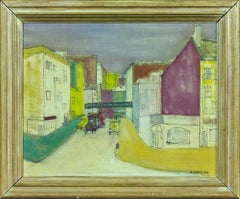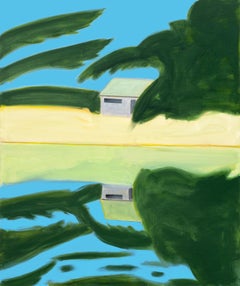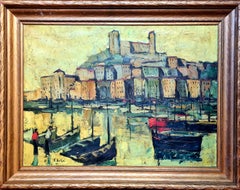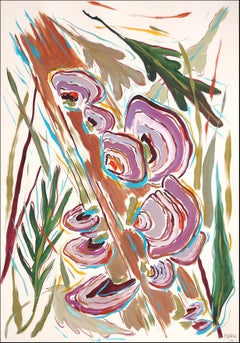Alex Katz Paintings
Flat color and minimal forms contrast the often monumental scales of the paintings by Alex Katz through which he creates portraits and landscapes of deceptive simplicity. Although the signature stark style that defines his prints and other work is now recognizable at a glance, it took him a decade to develop. During that time, he has said he destroyed hundreds of paintings.
Born in Brooklyn, New York, to Russian émigré parents, Katz’s family moved to Queens when he was a baby and that is where his family’s passion for the arts supported his early creative interests. In 1946, he enrolled at the Cooper Union in Manhattan where he studied painting under Morris Kantor. While he was influenced by the bold colors and hard edges of modernism, he shifted away from the then-dominant Abstract Expressionism movement to figurative scenes of life that have an inherent cool in their pared-down approach. Especially impactful were Katz’s summer studies between 1949 and 1950 at the Skowhegan School of Painting and Sculpture in Maine, a place where, as he later wrote: “I tried plein air painting and found my subject matter and a reason to devote my life to painting.”
Katz’s first solo show was in 1954 at Roko Gallery in New York. He experimented over the course of the following years with collage and painting on aluminum sheets, with his work in the 1960s drawing inspiration from film and advertising. In the 1970s, Katz expanded into portrait groups that regularly depicted the cultural scene of New York; in the 1980s, he extended his focus to fashion and its supermodels. Since the late 1950s, an enduring muse for his portraits has been his wife, Ada, while others have painted friends and famous figures. The intimate closeness of the frequently cropped faces in Katz’s portraits exudes a sense of tension with the subjects’ enigmatic expressions and planes of color.
In the 1960s, Katz collaborated with American dancer and choreographer Paul Taylor on sets and costumes. His concentration on landscapes emerged in the late 1980s, with atmospheric night views joining his practice, which had previously been defined by bright colors. Always finding new perspectives on his work, he has explored using iPhone photographs as the basis for large-scale compositions in recent years.
Katz’s prolific career has spanned sculpture, prints and public art along with his paintings and drawings, and his works can be found in the collections of leading museums such as the Metropolitan Museum of Art, Whitney Museum of American Art and Museum of Modern Art. He has had over 250 solo exhibitions around the world and continues to be acclaimed. In 2022, the Solomon R. Guggenheim Museum opened a major retrospective of his art.
Find Alex Katz art today on 1stDibs.
Early 2000s Contemporary Alex Katz Paintings
Oil, Board
1940s Modern Alex Katz Paintings
Canvas, Oil
2010s Contemporary Alex Katz Paintings
Archival Ink, Rag Paper
Mid-20th Century Modern Alex Katz Paintings
Canvas, Oil
2010s Modern Alex Katz Paintings
India Ink, Acrylic, Rag Paper
2010s Fauvist Alex Katz Paintings
India Ink, Acrylic, Rag Paper
2010s Naturalistic Alex Katz Paintings
Acrylic, India Ink, Rag Paper
2010s Modern Alex Katz Paintings
Acrylic, India Ink, Rag Paper
2010s Contemporary Alex Katz Paintings
Canvas, Dye, Emulsion, Cotton Canvas, Archival Ink, Mixed Media, Acrylic...
Mid-20th Century Modern Alex Katz Paintings
Canvas, Oil
Mid-20th Century Modern Alex Katz Paintings
Canvas, Oil
2010s Contemporary Alex Katz Paintings
Canvas, Dye, Emulsion, Cotton Canvas, Archival Ink, Mixed Media, Acrylic...
2010s Contemporary Alex Katz Paintings
Canvas, Dye, Emulsion, Cotton Canvas, Archival Ink, Mixed Media, Acrylic...
2010s Contemporary Alex Katz Paintings
Canvas, Dye, Emulsion, Cotton Canvas, Archival Ink, Mixed Media, Acrylic...
1970s Modern Alex Katz Paintings
Oil, Canvas
Alex Katz paintings for sale on 1stDibs.
Artists Similar to Alex Katz
- What media does Alex Katz use?1 Answer1stDibs ExpertApril 16, 2024What media Alex Katz uses varies. Over the course of his career, the American artist has worked in painting, sculpture and printmaking. Always finding new perspectives on his work, he has explored using iPhone photographs as the basis for large-scale compositions in recent years. On 1stDibs, shop an assortment of Alex Katz art.
- 1stDibs ExpertMarch 22, 2022Alex Katz is a contemporary artist who produced paintings, sculptures and prints. Many historians associate him with the Nouveau réalisme movement, but he also worked in figurative and Pop art styles. Shop a collection of Alex Katz art on 1stDibs.
- Is Alex Katz's style Pop art?1 Answer1stDibs ExpertMay 3, 2024Yes, Alex Katz's style is Pop art. During the 1950s, he experimented with collage and painting on aluminum sheets, with his later work in the 1960s drawing inspiration from film and advertising. In the 1970s, Katz expanded into portrait groups that regularly depicted the cultural scene of New York. In the 1980s, he extended his focus to fashion and its supermodels. These sources of inspiration align with Pop art's focus on transforming elements of popular culture into fine art. On 1stDibs, shop a collection of Alex Katz art.




